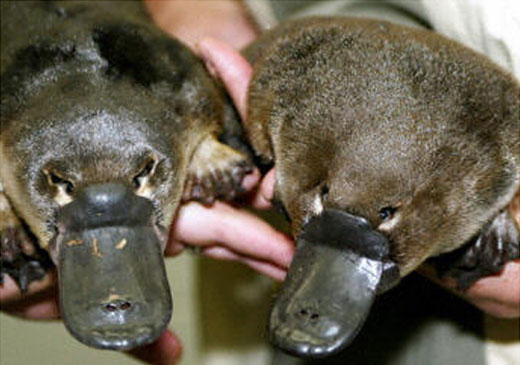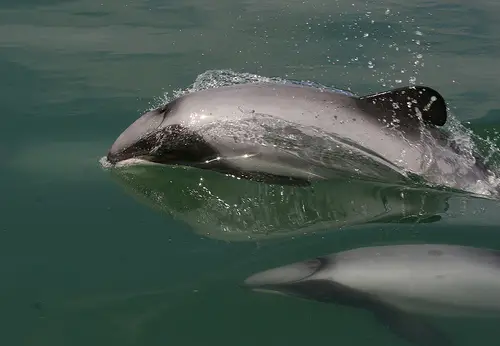Platypus
Platypus is mostly prevalent to Eastern Australia in Tasmania. It is a semi-aquatic mammal. It is one of the five species of monotremes. They are known as the only mammals that lay eggs rather than giving birth to the juvenile. In short, it is the sole representative of the family and genus, though quite a number of pertinent species have been located in the fossil record. With its egg-laying, duck-billed, beaver-tailed, otter-footed form, it comes across as having an odd appearance to the on-lookers. But, this strange appearance caught the eye of European Naturalists when they first stumbled upon it.

The Platypus
It being a venomous mammal, a spur on the hind foot of the male platypus delivers a poison capable of bringing severe pain to humans. It is one of the most interesting subjects to biologists in terms of evolutionary biology and is an identifiable and iconic symbol of Australia. Is has given appearance as a mascot in a number of national events. Also, it is featured on the reverse of the Australian 20 cent coin.
Description
Dense brown fur is surrounded on the body and the broad, flat tail of Platypus. Its tail is made use for storing reserves of fat. Similar adaptation is found in animals like the Tasmanian devil and fat tailed sheep. Also, webbed feet and large runnery snout also make the features of this animal. From 700g to 2.4 kg, the weight always varies in the case of this animal. Males are larger than females with the length being an average of 50cm for males and 43 cm for females.
Substantially, there is variation in both males and females. It may be due to the factors related to environment like predation and human encroachment. Its body temperature is of 31-32 degrees Celsius, unlike 37 degrees Celsius of those of placental mammals. The three-cusped molars which are equipped in modern platypus are lost in them just or before leaving the breeding burrow. Heavy keratinized pads are possessed by adults. The jaw of this mammal is built differently as compared to other mammals.

Two Platypus’s
Behavior
The platypus is endemic to small streams and rivers from the cold highlands of Tasmania and the Australian Alps to the tropical rainforests of coastal Queensland as far north as the base of Cape York Peninsula. So, it is semi-aquatic. The proper locations of its whereabouts are not yet well-known. However, it is known that it has become extinct in South Australia.
No longer is it found in the main part of the Murray-Darling Basin. It may be due to the diminishing quality of water caused by the extensive land clearing and irrigation schemes. The circulation of places by this animal remains capricious and mysterious as it disappears from some expected healthy rivers, but makes its presence appear in some other degraded and unexpected rivers. Besides, it is a first-class swimmer. It loves to spend its time in the water foraging for food.



yess i love those too! and the platypuss
after reading this website i think i might go out and buy a platypus!!!
i love it
they look so weird from the cartoons!!!!!
they are so cute
they are so cute i love them , i think im gonna buy some
They’re so so cute I want one!!!!! everytime my husband and i go for a walk near a creek, we hope to see a platty. But its probably not the right habitat. Dang It!!!
they are really different that i imaged. but you have to admit that they are really cute.
yeah i live over in missouri i aint seeing no platypus either honey!
I like platypusses! I want a platty! They are so cute! I must go get one! They look so furry and puffy and loveable!
I think that they are the cutest things ever! I want to snuggle one up and take it home. I can’t wait till the zoo here gets a platypus exhibit. I would want to see them every day. I want one for pet so badly. I might just be the first woman who wants to make a platypus sanctuary in her backyard. They are so adorable.
This website was good for the report i done about platypuses. thanks.
I love platypuses I realy want one as a pet!
i love the platypuses behaviour and there so cute!!!
ok… the platypus has always been the favorite animal of mine, but i’ve never known much about it because its so rare.Great job!!!
i love those creatures they are da best
i like them so much and do they come from austalia
i love platypus they r cute i really want to buy in south America the have one of them they cost only 10000$
i like it so much and i meen it
Leave animals where they belong!!
Respect their nature, do not buy one for your own purpose…
wow that isactually alot of money
hi are you ok and i like them so much and i love them to and can you go to ellies plzz
haha
the platypus is soooooooooooo adorable and i think iif someone wants a platypus as a pet then they should get one!!!!!!!!!!!!!!!!!!!!!!!!!!!!!!!!!!!!!!!!!!!!!!!!
its perry the platypuss :)
you and perry should go have anal intercourse and have retarted babies because you and perry are faggots and i hope you kill yourself along with every person that has ever respected you
hey that is kind of harsh ;-(
DAMM what the fck is you sayinq shit wach your mouth… shit you nt know what your saying shit you sure got a bad ATTITUDE SHIT
they r so cute i wont to buy one
that is a mammal i diddnt know this!!!
* they look wierd *
platypi are the only poisonous egg laying mammals in the world …. STICK THAT UP A SCIENTISTS ASS !!!!!
what a great animal, because it have mouth like a duck and a tail like a beaver
that was mean for yuee to say ;( i like platypus their so cute !!
did u know they are killer they have spears
They are Venomous…. so you might want to watch out before you want to have one as a pet…
Or you might find your kids all over the backyard or the house… leave the creatures of the nature where they belong, or I might get you as a pet, and put you in a tank so you can swim around, and then we’ll see how you like it…. =)
Nope, they don’t kill, their venom is just painful… But they are soo cool… I wanna have one.. Lucky Australians may keep it as a pet (with licence, of course)… :)
Bill you suck